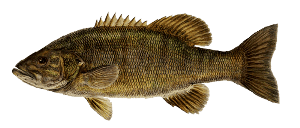Characteristics
 The Smallmouth Bass, also known as “Smallmouth” have a brownish body. Its mouth extends up to its eye, different from the Largemouth Bass where its mouth extends beyond the eye. The notch between it’s the pointed and soft dorsal fins on it’s back is less noticeable. It’s markings are irregular vertical bars and its body is dark brown on top and a cream-like bottom belly.
The Smallmouth Bass, also known as “Smallmouth” have a brownish body. Its mouth extends up to its eye, different from the Largemouth Bass where its mouth extends beyond the eye. The notch between it’s the pointed and soft dorsal fins on it’s back is less noticeable. It’s markings are irregular vertical bars and its body is dark brown on top and a cream-like bottom belly.
Smallmouth range between 2-3 pounds, however, larger adult Smallmouth can grow up to 5 pounds.
Smallmouth will put up a good fight before you can land them. This is a great fish for those who want more of a challenge than fishing for perch or pan fish.
Habitat
Smallmouth prefer clear water that has gravel and rubble for spawning. Most Smallmouth prefer rivers. They are usually found by rocks, however they gravitate toward gravel up to 1 inch so they can build their nest and spawn.
Female Smallmouth Bass spawn in water temperatures starting in the low 60s degree. Males will fertilize the eggs after the female spawns. Smallmouth do not do well in extreme warm temperatures. Smallmouth are found in any water that have a streamflow and a slight current. This brings more oxygen to the water, which Smallmouth thrive in.
In the spring time, the Smallmouth moves towards shallow water with gravel. The male builds the nest by fanning out a shallow dish shape nest with its tail. The female can lay 2,000 – 10,000 eggs. Once it lays the eggs the female Smallmouth moves to deeper water. The male Smallmouth will protect the nest from predators until the eggs hatch. Rapid change in weather to a colder temperature will result in the male Smallmouth moving toward deeper water leaving the nest unprotected and vulnerable to predators.
Male and female Smallmouth usually don’t feed until the eggs hatch and are ready to move on. Once that occurs the Smallmouth will resume feeding.
The Smallmouth will move towards sheltered area to feed. They enjoy invertebrates like crayfish. Most of the time the Smallmouth will feed in shallow areas but as the summer progresses they then to move toward deeper water.
Smallmouth have a tendency to move away from their habitat in the fall when the temperature drops below 60 degrees. They can move through streams to find a resting area. Most Smallmouth will then school together and become sluggish and eat very little during this time, however, anglers may still be successful in catching Smallmouth during this season.
Equipment
It is recommended that you use medium action rods and reels with 8 pound test line. Smallmouth respond to live bait like leeches and minnows. Any type of bait that resembles the colors of crayfish should be used.
Smallmouth Bass are easy to pull out of the water by their mouth because their mouth opens widely making it also easy to remove your lures/bait.
Tips for Fishing
Although Smallmouth have teeth, you can usually handle them without feeling like they will bit you. Their an easy fish to fish for. If you look for boulders in the water or a rocky, gravel structures you’re sure to find a Smallmouth Bass hiding there.

